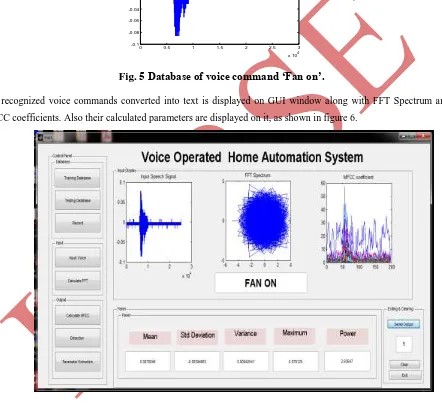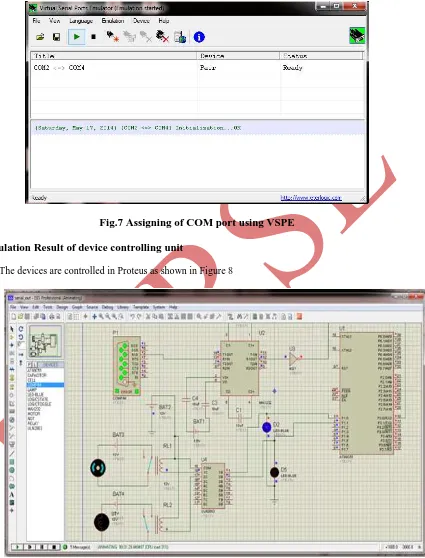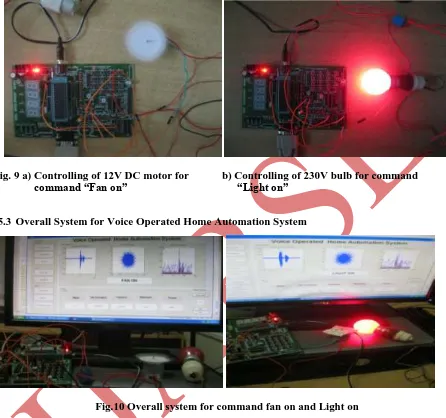GUI BASED REAL-TIME HOME AUTOMATION SYSTEM
OPERATED BY VOICE COMMAND
Rutuja V. Patil¹, Pratik V. Patil².
¹ M.Tech, Department of Electronics and Telecommunication Engineering,
Rajarambapu Institute of Technology, Rajaramnagar, Islampur, (India).
²B.E, Department of Electronics and Telecommunication Engineering,
Dr. D. Y. Patil Institute of Engineering and Technology,Pimpri, Pune, (India).
ABSTRACT
This paper presents the design and implementation of a Home Automation system Operated by Voice Command. It
uses human-computer interaction to control different devices. In this paper, ASR (Automatic Speech Recognition)
has been used. The automatic speech recognition (ASR) system is used to accurately and efficiently convert a speech
signal into a text message by using MATLAB. The speech signal is captured by using microphone. This signal is
pre-processed at front-end for feature extraction using Mel Frequency Cepstrum Coefficient (MFCC). The obtained
features are compared at back end for pattern matching using Dynamic Time Wrapping (DTW). After comparing
features of recorded voice with database, controlling command is send to microcontroller to control devices. This
system is helpful for quadriplegia and blind people.
Keywords
: Home Automation, ASR, Feature Extraction, MFCC, Pattern Matching, GUI, VSPE.I.
INTRODUCTION
Home Automation becomes increasingly popular, people are in need of more home automation devices to upgrade
their living spaces and enjoy a high-tech life. House is equipped with various consumer devices, that are generally
controlled and managed manually or using different remote controls. But it is very difficult to control the multiple
household appliances for elder people and people with disabilities such as quadriplegia patients and blind people.
Automatic Speech Recognition (ASR) is mostly used system for speech recognition. ASR system accurately and
efficiently converts a speech signal into a text message independent of the device, speaker or the environment. In
general the speech signal is captured and pre-processed at front-end for feature extraction and evaluated at back-end.
II. LITERATURE REVIEW
The reviews of literature and the technological aspects of human machine interaction through various speech
recognition approaches are discussed. It also discusses the various techniques used in each step of a speech
recognition process and attempts to analyze an approach for designing an efficient system for speech recognition
The non-parametric method for modeling the human auditory perception system, Mel Frequency Cepstral
Coefficients (MFCCs) are utilize as extraction techniques. The non linear sequence alignment known as Dynamic
Time Warping (DTW) is introduced. This paper presents the viability of MFCC to extract features and DTW to
compare the test patterns [3].
This paper describes an approach of isolated speech recognition by using the Mel-Scale Frequency Cepstral
Coefficients (MFCC) and Dynamic Time Warping (DTW). MFCC are extracted from speech signal of spoken
words. To cope with different speaking speeds in speech recognition Dynamic Time Warping (DTW) is used [4].
Numeral recognition remains one of the most important problems in pattern recognition. This paper has discussed an
effective method for recognition of isolated Marathi numerals. It presents a Marathi database and isolated numeral
recognition system based on Mel-Frequency Cepstral Coefficient (MFCC) used for Feature Extraction and Distance
Time Warping (DTW) used for Feature Matching or to compare the test patterns [5][6].
III. SPEECH DATABASE.
For accuracy in the key word recognition, we need a collection of utterances, which are required for training and
testing. The collection of utterances in proper manner is called database. The total number of speakers was ten.
3.1 Acquisition Setup
To achieve a high accuracy for key word recognition in home automation system we use 10×10 room for recording some key words without noisy sound. The Sampling frequency for all recordings was 11025 Hz. The speaker were
Seating in front of the direction of the microphone. The distance of mouth to microphone is about 5-10 cm. The
speech data is collected with the help voice recorder of PC.
3.1.1Create isolated key words (database)
We have recorded isolated word commands such as Fan on, Fan off, Light on, Light off. The speech data is
recorded with the help of wavrecord command and store in database using wavwrite command. The speech signals
have been stored in form of wav file and given the labels of spoken words to the different files.
IV. PRINCIPLE OF VOICE RECOGNITION
4.1. Mel Frequency Cepstral Coefficient
There are several kinds of parametric representation of the acoustic signals. Among of them the Mel-Frequency
Cepstral Coefficient (MFCC) is most widely used. MFCC takes human perception sensitivity with respect to
frequencies into consideration, and therefore are best for speech recognition. The extraction of the features of
acoustic signals is an important task to produce a better recognition performance. The correctness of this phase is
important for the next phase since it affects its behavior. MFCC is based on human hearing perceptions. MFCC has
1000Hz. A subjective pitch is present on Mel Frequency Scale to capture important characteristic of phonetic in
speech.
Figure 1 shows Home Automation System Operated by Voice Command. In this block diagram we used MFCC and
DTW technique for Key word recognition. Hardware is designed using these components microcontroller, Relay
Driver Circuit, Relays, microphone, and RS232-Serial communication etc.
Fig.1 Proposed system of Home Automation System Operated by Voice Command.
4.1.1Pre-emphasis
This step processes the passing of signal through a filter which emphasizes higher frequencies. This process will
increase the energy of signal at higher frequency in order to improve SNR.
The goal of pre-emphasis is to compensate the high frequency part that was suppressed during the sound production
mechanism of humans.
4.1.2 Framing and Windowing
Theprocess of segmenting the speech samples into a small frame with the length within the range of 20 to 40 msec.
In this step the continuous speech signal is blocked into frames of N samples, with adjacent frames being separated
by M (M < N). The first frame consists of the first N samples. The second frame begins M samples after the first
frame, and overlaps it by N - M samples. Overlapping rate is 50% to avoid the risk of losing the information from
The next step in the processing is to window each individual frame so as to minimize the signal discontinuities at
the beginning and end of each frame. The concept here is to minimize the spectral distortion by using the window to
taper the signal to zero at the beginning and end of each frame. Hamming window is used here.
4.1.3 Fourier Transform
To obtain a good frequency resolution, a 512 point Fast Fourier Transform (FFT) is used, which converts each frame
of N samples from the time domain into the frequency domain.
4.1.4 Mel-Frequency Filter Bank
The frequencies range in FFT spectrum is very wide and voice signal does not follow the linear scale. Thus for each
tone with an actual frequency, f, measured in Hz, a subjective pitch is measured on a scale called the „Mel‟ scale.
The Mel-frequencyscale is linear frequency spacing below 1000 Hz and a logarithmic spacing above 1000 Hz. As a
reference point, the pitch of a 1 kHz tone, 40 dB above the perceptual hearing threshold, is defined as 1000 Mels.
Therefore we can use the formula in Equation 4 to compute the Mels for a given frequency fin Hz.
4.1.5 Discrete Cosine Transform
Mel-cepstrum coefficients contain only real part. We can convert them to the time domain using the Discrete Cosine
Transform (DCT). The set of coefficient is called acoustic vectors.
0 20 40 60 80 100 120 140 160 180 200
0 1 2 3 4 5 6 7 8
4.2 Dynamic Time Warping
The features extracted from each command word using MFCC are stored as a data base. When a valid command
word is taken for testing, the MFCC of that command is computed. This is compared with the MFCCs stored in the
data base and matched using the technique of dynamic time warping. Dynamic programming is an extensively
studied and widely used tool in operation research for solving sequential decision problems. Dynamic time warping
(DTW) is an algorithm for measuring similarity between two sequences which may vary in time or speed. The
feature vector obtained from the incoming input speech has to be compared with the feature vectors in the data base.
One of the popular methods of comparing two feature vectors is to calculate the Euclidian distance between the two
feature vectors. The formula used to calculate the Euclidean distance can be defined as following:
The Euclidean distance between two points
is given by the formula
ED = (
Word which gives the least distance is identified as the command word.
The problem with this approach is that different command word has different length. Hence the feature vectors will
be of different lengths. The matching process needs to compensate for length differences and take account of the
non-linear nature of the length differences within the words. The Dynamic Time Warping algorithm achieves this
goal; it finds an optimal match between two sequences of feature vectors which allows for stretched and compressed
sections of the sequence.
Consider two time series Q and C of length n and m respectively.
To align two sequences using DTW we construct an n-by-m matrix where the (i ͭ ͪ, j ͭ ͪ) element of the matrix contains
the distance d between the two points. Warping path W is a contiguous set of matrix elements that defines a
mapping between Q and C.
Fig. 4 Minimum path between stored and reference keyword.
4.3 Device Controlling Unit
4.3.1Using Simulation in PROTEUS
The devices like bulb are controlled by using Proteus software and Keil software. According to recognized word
command, the specific data is send to controller through serial communication. For interfacing of Matlab with
Proteus through serial communication, we use Virtual Serial Port Emulator Software (VSPE). In Proteus data is
received by COMPIN and send to microcontroller through Max232. The received data send to port pins for
controlling devices.
4.3.2Using Hardware
In actual implementation of device controlling unit we use 8051 development board to control devices. In this
Matlab send specific data to P89V51RD2 controller via serial communication and MAX 232 IC. This received data
V. RESULT
The recorded database of voice commands is as shown below in Figure 5.
0 0.5 1 1.5 2 2.5 3
x 104 -0.1
-0.08 -0.06 -0.04 -0.02 0 0.02 0.04 0.06 0.08
Fig. 5 Database of voice command „Fan on‟.
The recognized voice commands converted into text is displayed on GUI window along with FFT Spectrum and
MFCC coefficients. Also their calculated parameters are displayed on it, as shown in figure 6.
Fig. 6 GUI for “Fan On“ Command
Fig.7 Assigning of COM port using VSPE
5.1 Simulation Result of device controlling unit
The devices are controlled in Proteus as shown in Figure 8
5.2
Hardware implementation of device controlling unit
Fig. 9 a) Controlling of 12V DC motor for b) Controlling of 230V bulb for command
command “Fan on” “Light on”
5.3 Overall System for Voice Operated Home Automation System
Fig.10 Overall system for command fan on and Light on
VI. CONCLUSION
We have successfully implemented voice recognition system using MATLAB. The recognized voice commands are
displayed on GUI in text form. As voice command is recognized by MATLAB, the specific data is send to
microcontroller. The controlling of devices using microcontroller is implemented according to received data using
Proteus. This system is targeted at elder, blind and quadriplegia people.
REFERENCES
Journal Papers
[1] Krishan Kant Lavania, Shachi Sharma and Krishna Kumar Sharma,” Reviewing Human-Machine Interaction
through Speech Recognition approaches and Analyzing an approach for Designing an Efficient System”
International Journal of Computer Applications, Volume 38, 2012.
[2] Aarti V. Jadhav and Rupali V. Pawar, “Review of Various Approaches towards Speech Recognition”,
International Conference on Biomedical Engineering, pp: 99 – 103, IEEE, 2011.
[3] Lindasalwa Muda, Mumtaj Begam and I. Elamvazuthi, “Voice Recognition Algorithms using Mel Frequency Cepstral Coefficient (MFCC) and Dynamic Time Warping (DTW) Techniques”, Journal of Computing, Vol.2,
issue 3, March 2010.
[4] Shivanker Dev Dhingra, Geeta Nijhawan, Poonam Pandit, “Isolated speech recognition using MFCC and DTW”, International Journal of Advanced Research in Electrical, Electronics and Instrumentation Engineering, Vol. 2,
August 2013.
[5] “Speech Processing for Marathi Numeral Recognition using MFCC and DTW Features”, International Journal of
Engineering Research and Applications (IJERA) ISSN: 2248-9622 National Conference on Emerging Trends in
Engineering & Technology (VNCET-30 Mar‟12.
[6] Bharti W. Gawali, Santosh Gaikwad, Pravin Yannawar, Suresh C.Mehrotra, “Marathi Isolated Word Recognition
System using MFCC and DTW Features” ACEEE Int. J. on Information Technology, Vol. 01, No. 01, Mar 2011
[7] Katti and Anusuya,” Speech Recognition by Machine: A Review”, International Journal of Computer Science






